
NVIDIA GeForce GTX 275
Written by John Yan on 4/1/2009 for
PC
More On:
GeForce GTX 275
The fight for mid-range is going to be upped again. Last time, I reviewed the GeForce GTS 250 which was close to a rebranding of an earlier card. Well, this time around we've got a more original product though in the GeForce GTX 275. Does this new card have the goods to take the mid-range arena?
Let's go over the specs of the card. The GeForce GTX 275 is built on the 55nm process and has a graphics clock speed of 633MHz with the shader units running at 1404MHz. For memory, the GeForce GTX 275 comes equipped with 896MB of GDDR3 memory clocked at 1134MHz. Hardware wise, the card sports a 448-bit memory interface and has 240 stream processor units. You can call it a marriage between the GeForce GTX 280 and the GeForce GTX 260 because it takes the 240 stream processor amount from the 280 and combines it with the 448-bit memory interface and the memory amount of the 260. Clocks are however more than the 280 so there are some items that deviate from the two. Now, there's not too much new here and for the most part and we're getting to a year here with the technology produced by them so I'm hoping we see some new hardware technologies coming in from NVIDIA soon. Until then, the GeForce GTX 275 falls in line still with their current generation of cards in that sense.

For features, there's nothing new in terms of technology support over say the GeForce GTX 280. You're looking at support for the same things such as DirectX10, CUDA, PhysX, Lumenex, and so forth. Again, no DirectX 10.1 support but there doesn't seem to be too much these days in terms of software anyways to warrant this and I'm guessing NVIDIA would move on to DirectX 11 support future cards anyways while adding 10.1 to those cards. What we do have though is a change in speeds and thus the card is priced at a more affordable plateau. It's really meant to sit between the 260 and 280 in the GeForce line and was made to compete with ATI's Radeon HD 4890 which is being released on the same day. The card's MSRP is $249 which as we'll get into later is a pretty good price.
The card is 10.5 inches in length making it pretty average length card for these days. The reference card sent to us takes up two slots and has two six pin power connectors. The power connectors face vertically making it easier to reach in most situations. The maximum draw of the card is 219 watts and as usual, that's in extreme situations. Two Dual Link-DVI connectors are the only connections available on this card but I'm sure board partners will put in items such as TV connectors for those that want to connect this card to a TV using component connections. 2 and 3-way SLI is supported with the GeForce GTX 275 card and you can see in the pictures the SLI connectors on top of the card.
With the launch of the card comes revision 185 drivers. Besides the normal fixes and general improvements on performance, 185 drivers adds a new visual feature to toggle. Ambient occlusion is now in the NVIDIA control panel and will enable this feature on games that aren't supported natively. Two examples that were reported to me were Half-Life 2 and World in Conflict. Take a point and ambient occlusion determines how much ambient light that point receives based on various factors. In the screenshot below, you can see the effect where the walls meet as well as the soft shadow generated behind the phone. A more pronounced effect is the World in Conflict picture where you can see the blades of grass creating this effect producing a more realistic outdoor scene. All this comes at a performance cost of course as you'll get roughly a 20-40% drop in framerate depending on the resolution and features turned on of course. Some games already have this feature built in such as Crysis but the drivers are meant for games that don't have ambient occlusion as a feature of their game. The list provided by NVIDIA has 22 games enabled in the profile by default and there's a lot of current popular games on there. We'll test to see in some games how much this hurts when turning the feature on compared to it being off.It's tough to not also talk about the other things NVIDIA brings forth when reviewing one of their cards. PhysX is getting more and more prominent and NVIDIA cards like the GeForce GTX 275 will offer hardware acceleration in games that support this feature. Now having a single card to do 3D and PhysX can be a little taxing so if you do have a spare NVIDIA GeForce 8 series and up card around, you can pop it in and have that card handle the PhysX acceleration for you freeing up your main video card to handle the grunt work of 3D video. I'm going to hold off on the PhysX performance and features for a future article when I have more time to spend with a few configurations but from my previous review of the GeForce GTS 250, I really liked what I saw and it added a lot of nice visual effects. A new Sacred 2 patch was just recently released adding PhysX features so if you have the game and a GeForce 88XX GTX card and up you might want to pick up the patch to see some added spell and environmental effects.
Finally, as a programmer I love things like CUDA. CUDA can turn your graphics card into a high powered processing general purpose multi-cored CPU. For programs that have a lot of parallel processing needs, CUDA can really help speed things up. There are a few video-centric applications that utilize CUDA to help speed up transcoding or media processing times using the GeForce GTX 275 card to do all the heavy grunt work and freeing up the computer's CPU. So, you can theoretically use your GeForce GTX 275 with the supported application to transcode a large media file into another format and still have enough CPU cycles to do other work such as browsing the web, word processing, or answering email. Not only does CUDA enabled applications free up your CPU but they can also perform tasks a lot faster because of the multiple processing cores on the card. I'm going to be adding a news item showing off some of the cool effects you can achieve with a program called vReveal which takes advantage of CUDA soon so be sure to look for that.
Tests were done with the 185.63 drivers from NVIDIA. We pitted the card against Radeon HD 4870 with 1MB on board overclocked to Radeon HD 4890 specifications of 850MHz GPU and 975MHz memory because we didn't have a Radeon card on hand at this time. Catalyst 9.3 drivers were used with the AMD card. Right now, NVIDIA has a little bit newer versions of their drivers out but compared to what was tested, there are some minor changes that won't affect any of the tests.
The test system includes:
Intel Q6700 Quad Core
4GB of ram
Vista Ultimate 64-bit
ECS PN2 SLI2+ motherboard
First up is the synthetic benchmark 3DMark Vantage. Settings were set at default for the test and the resolution was set at 1280x1024.
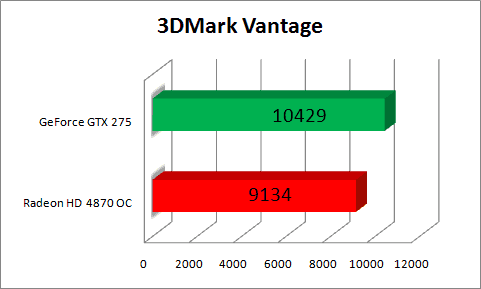
Now let's get to some games. I've updated my library of games to test so there will be some new ones in here. Far Cry 2 was tested at 1600x1200 with everything set to the maximum. There's a built in benchmark that Far Cry has and I used the Action benchmark to test both cards.
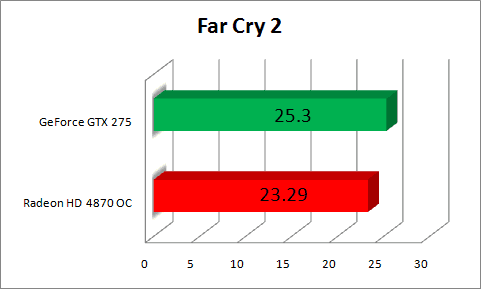
Here the GeForce GTX 275 has a slight lead over Radeon card in Far Cry 2.
Fallout 3 was run using a saved game near Dupont Circle. Again, all settings were maxed out with AA and AF turned off for the tests. Draw distances were also set to max and resolution was set at 1600x1200. I followed a path and fired a rocket into a car at the end to cause a massive explosion. Fraps was used to record the frames per second.
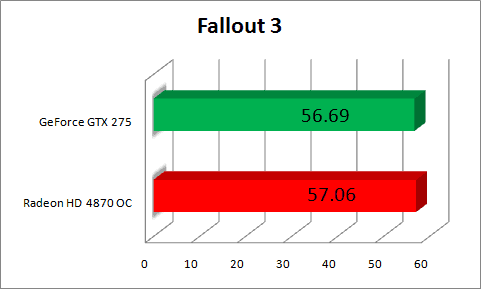
This time around, the Radeon card pulls ahead of the GeForce GTX 275 but only by a slim margin after averaging out all the runs I did with both cards.
Dawn of War II just came out not too long ago and it uses an enhanced Company of Heroes engine. Settings were maxed out as much as I can with a resolution of 1600x1200. I played through the beginning in game cinematic where it pans through a battle going on. Fraps was used to record the results.
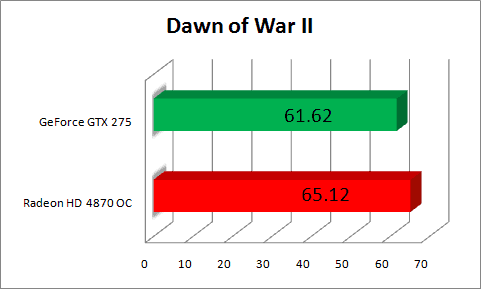
This time though, the Radeon card has small but a healthier lead once the runs were averaged together. Both cards are still running the game well but for Dawn of War II, the Radeon card seems to run the game a little better than the GeForce card.Tom Clancy's H.A.W.X. just came out and here I used the demo to test the performance of both cards. The demo has a built in benchmark where it does a flyby through the land. Again, all settings were set to the maximum and resolution was set at 1600x1200 for the tests.
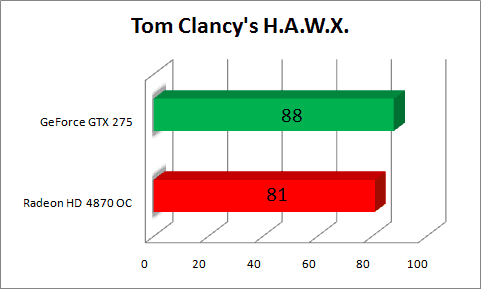
The demo doesn't go into any decimal digits for showing frames per second but you can see the GeForce GTX 275 having a good lead over the Radeon HD 4870 OC card in this test.
Left 4 Dead is a game I constantly play almost every day. Settings were set at maximum with a resolution of 1600x1200 and I recorded a portion of the boat house final for the Death Toll campaign. Using the recorded demo, I played it back using the built in timedemo feature of the Source Engine.
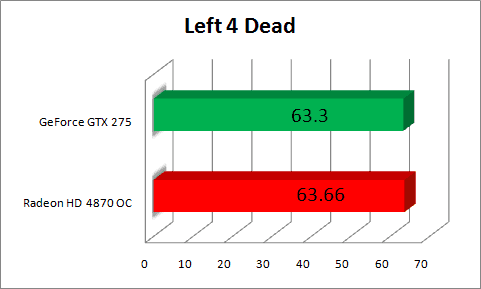
Both cards performed pretty much the same here and multiple runs showed it to be on average with both cards providing good performance
Finally Mirror's Edge rounds out the test suite here. PhysX was turned off but everything else was maxed out with a resolution of 1600x1200. I ran through the flyby demo and used Fraps to record the results.
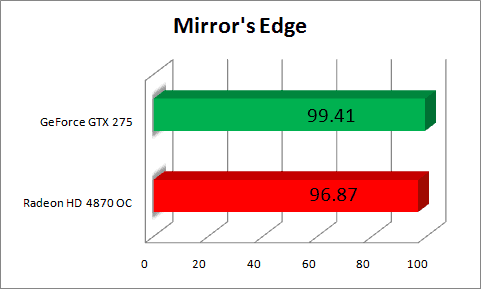
The GeForce GTX 275 card came out ahead time time around with a 3FPS lead over the Radeon HD 4870 OC.
From the battery of tests, you can see that the GeForce GTX 275 and the overclocked Radeon HD 4870 to Radeon HD 4890 specs trade off in a few games. Depending on the software you are running you'll either see one over take the other a little bit but there are some items such as Tom Clancy's H.A.W.X. or the 3D Mark Vantage where the GeForce GTX 275 pulls away. As far straight performance goes one isn't dominant over the other as they both offer good performance. Now, what I do have is an overclocked card so having a true Radeon HD 4890 might be a little different but as I said, the Radeon HD 4870 was overclocked stabily to Radeon 4890 specifications so if that's any indication, I don't see either card being really dominant over the other when you take all games into account. With that said, I really liked how the card performed and at the price that it's set at, you're getting a good deal but that's not where it stops.
Now, where the value might come in though is the amount of CUDA apps available, PhysX, and the ambient occlusion driver feature that NVIDIA has. With those factored in, the GeForce GTX 275 does seem to have a little better value if you are going to be playing games or using utilities that support those. There are some cool CUDA apps out there though but they are all very multimedia heavy for now. I do do a lot of transcoding and fixing up of videos so right there the card has an added value to me. Also, I have a few extra NVIDIA cards that can be used to accelerate physics with PhysX games so again, the value of the GTX 275 raises slightly a little more in that I have the ability to trake advantage of the technology. Even without the extra card, you'll still be able to get PhysX boost with the single GeForce GTX 275 card. Right now, there aren't really that many ATI Stream nor is the Havok accelleration prominent in games but until then I have to give NVIDIA the edge here.As I touched on earlier, ambient occlusion will improve the way the objects show depth by casting soft shadows in corners or around it depending on where the light source is. I did run into a problem with Fallout 3 and Left 4 Dead sometimes. Fallout 3 would not load up a saved game that I have with ambient occlusion on. It would just be a black screen when the saved game loaded and my Fraps showed it stuck at 1FPS before the game errored out. Unticking the feature in the control panel allowed me to load the saved game without any problem. Starting a brand new game in Fallout 3 allowed me to play with the feature on and as you can see below the difference with both ambient occlusion on and off. Left 4 Dead had a problem once or twice where my timedemo wouldn't start at all too. So, while the feature does create some nice subtle effects, there could be some stability issues in games. Seeing as this is the first time the feature has been put in the driver set and if others run into the same problem I do, I'm confident NVIDIA will fix these issues in the future. For now though from my testing, you might have some issues playing some of the games on the list. But take a look at the two screenshots below and of note, the button panel and the ledge holding up the Nuka-cola toy car. You can see the soft shadows that are created are more pronounced with the feature on.
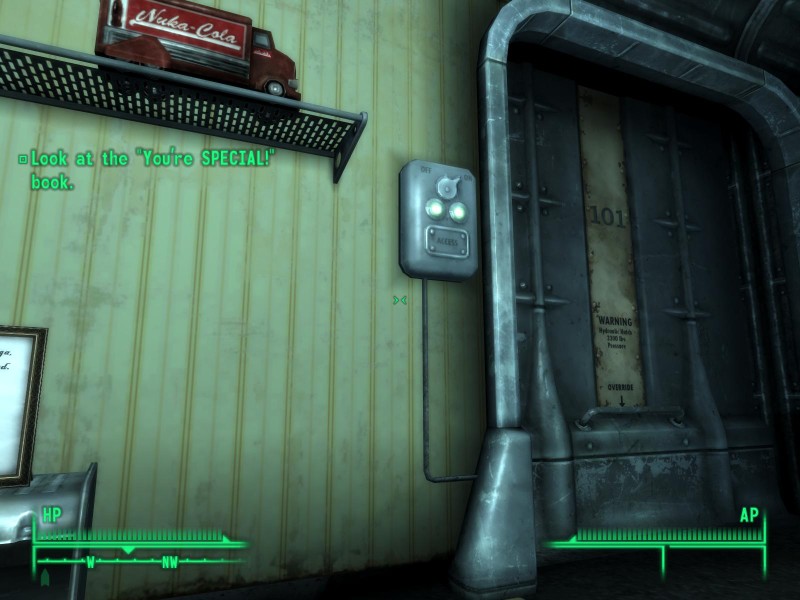
Ambient Occlusion OFF
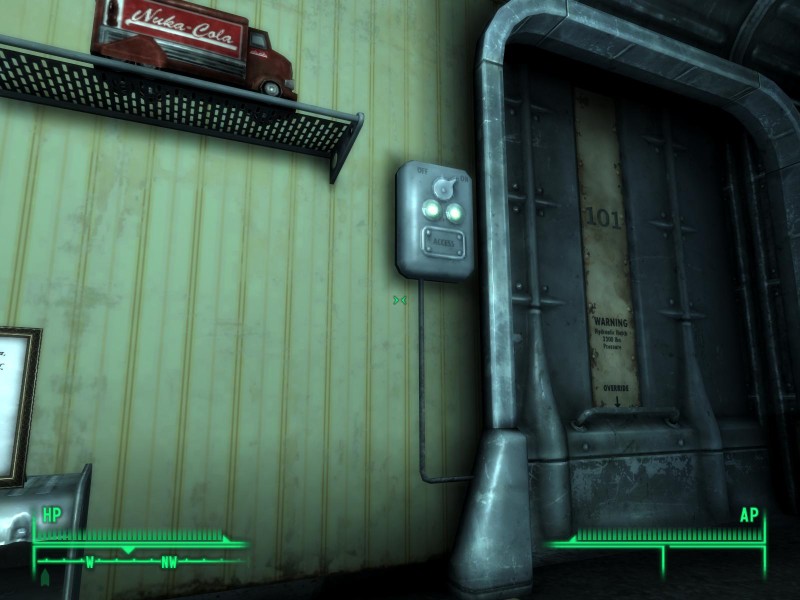
Ambient Occlusion ON
At $249, the price of the card puts it in a very afford range and is the same non-rebate price of the ATI Radeon HD 4890. Availability though right now is pretty low but it's expected to ramp up by April 14th whereas you can pick up the ATI Radeon HD 4890 now. So, while it's up to two weeks in terms of being able to pick up the card, it's not too long of a wait if you really want the GeForce GTX 275. The card fits nicely in the spot between the 260 and 280 in terms of price and performance. With more CUDA apps, PhysX games, and GeForce 3D Vision games coming out, you're getting a card with a nice future ahead and should be a nice hold over until the next generation of NVIDIA cards come out.
Let's go over the specs of the card. The GeForce GTX 275 is built on the 55nm process and has a graphics clock speed of 633MHz with the shader units running at 1404MHz. For memory, the GeForce GTX 275 comes equipped with 896MB of GDDR3 memory clocked at 1134MHz. Hardware wise, the card sports a 448-bit memory interface and has 240 stream processor units. You can call it a marriage between the GeForce GTX 280 and the GeForce GTX 260 because it takes the 240 stream processor amount from the 280 and combines it with the 448-bit memory interface and the memory amount of the 260. Clocks are however more than the 280 so there are some items that deviate from the two. Now, there's not too much new here and for the most part and we're getting to a year here with the technology produced by them so I'm hoping we see some new hardware technologies coming in from NVIDIA soon. Until then, the GeForce GTX 275 falls in line still with their current generation of cards in that sense.

For features, there's nothing new in terms of technology support over say the GeForce GTX 280. You're looking at support for the same things such as DirectX10, CUDA, PhysX, Lumenex, and so forth. Again, no DirectX 10.1 support but there doesn't seem to be too much these days in terms of software anyways to warrant this and I'm guessing NVIDIA would move on to DirectX 11 support future cards anyways while adding 10.1 to those cards. What we do have though is a change in speeds and thus the card is priced at a more affordable plateau. It's really meant to sit between the 260 and 280 in the GeForce line and was made to compete with ATI's Radeon HD 4890 which is being released on the same day. The card's MSRP is $249 which as we'll get into later is a pretty good price.
The card is 10.5 inches in length making it pretty average length card for these days. The reference card sent to us takes up two slots and has two six pin power connectors. The power connectors face vertically making it easier to reach in most situations. The maximum draw of the card is 219 watts and as usual, that's in extreme situations. Two Dual Link-DVI connectors are the only connections available on this card but I'm sure board partners will put in items such as TV connectors for those that want to connect this card to a TV using component connections. 2 and 3-way SLI is supported with the GeForce GTX 275 card and you can see in the pictures the SLI connectors on top of the card.
With the launch of the card comes revision 185 drivers. Besides the normal fixes and general improvements on performance, 185 drivers adds a new visual feature to toggle. Ambient occlusion is now in the NVIDIA control panel and will enable this feature on games that aren't supported natively. Two examples that were reported to me were Half-Life 2 and World in Conflict. Take a point and ambient occlusion determines how much ambient light that point receives based on various factors. In the screenshot below, you can see the effect where the walls meet as well as the soft shadow generated behind the phone. A more pronounced effect is the World in Conflict picture where you can see the blades of grass creating this effect producing a more realistic outdoor scene. All this comes at a performance cost of course as you'll get roughly a 20-40% drop in framerate depending on the resolution and features turned on of course. Some games already have this feature built in such as Crysis but the drivers are meant for games that don't have ambient occlusion as a feature of their game. The list provided by NVIDIA has 22 games enabled in the profile by default and there's a lot of current popular games on there. We'll test to see in some games how much this hurts when turning the feature on compared to it being off.It's tough to not also talk about the other things NVIDIA brings forth when reviewing one of their cards. PhysX is getting more and more prominent and NVIDIA cards like the GeForce GTX 275 will offer hardware acceleration in games that support this feature. Now having a single card to do 3D and PhysX can be a little taxing so if you do have a spare NVIDIA GeForce 8 series and up card around, you can pop it in and have that card handle the PhysX acceleration for you freeing up your main video card to handle the grunt work of 3D video. I'm going to hold off on the PhysX performance and features for a future article when I have more time to spend with a few configurations but from my previous review of the GeForce GTS 250, I really liked what I saw and it added a lot of nice visual effects. A new Sacred 2 patch was just recently released adding PhysX features so if you have the game and a GeForce 88XX GTX card and up you might want to pick up the patch to see some added spell and environmental effects.
Finally, as a programmer I love things like CUDA. CUDA can turn your graphics card into a high powered processing general purpose multi-cored CPU. For programs that have a lot of parallel processing needs, CUDA can really help speed things up. There are a few video-centric applications that utilize CUDA to help speed up transcoding or media processing times using the GeForce GTX 275 card to do all the heavy grunt work and freeing up the computer's CPU. So, you can theoretically use your GeForce GTX 275 with the supported application to transcode a large media file into another format and still have enough CPU cycles to do other work such as browsing the web, word processing, or answering email. Not only does CUDA enabled applications free up your CPU but they can also perform tasks a lot faster because of the multiple processing cores on the card. I'm going to be adding a news item showing off some of the cool effects you can achieve with a program called vReveal which takes advantage of CUDA soon so be sure to look for that.
Tests were done with the 185.63 drivers from NVIDIA. We pitted the card against Radeon HD 4870 with 1MB on board overclocked to Radeon HD 4890 specifications of 850MHz GPU and 975MHz memory because we didn't have a Radeon card on hand at this time. Catalyst 9.3 drivers were used with the AMD card. Right now, NVIDIA has a little bit newer versions of their drivers out but compared to what was tested, there are some minor changes that won't affect any of the tests.
The test system includes:
Intel Q6700 Quad Core
4GB of ram
Vista Ultimate 64-bit
ECS PN2 SLI2+ motherboard
First up is the synthetic benchmark 3DMark Vantage. Settings were set at default for the test and the resolution was set at 1280x1024.

For GPU score, the GeForce GTX 275 has a lead over the overclocked Radeon HD 4870.

Here the GeForce GTX 275 has a slight lead over Radeon card in Far Cry 2.
Fallout 3 was run using a saved game near Dupont Circle. Again, all settings were maxed out with AA and AF turned off for the tests. Draw distances were also set to max and resolution was set at 1600x1200. I followed a path and fired a rocket into a car at the end to cause a massive explosion. Fraps was used to record the frames per second.

This time around, the Radeon card pulls ahead of the GeForce GTX 275 but only by a slim margin after averaging out all the runs I did with both cards.
Dawn of War II just came out not too long ago and it uses an enhanced Company of Heroes engine. Settings were maxed out as much as I can with a resolution of 1600x1200. I played through the beginning in game cinematic where it pans through a battle going on. Fraps was used to record the results.

This time though, the Radeon card has small but a healthier lead once the runs were averaged together. Both cards are still running the game well but for Dawn of War II, the Radeon card seems to run the game a little better than the GeForce card.Tom Clancy's H.A.W.X. just came out and here I used the demo to test the performance of both cards. The demo has a built in benchmark where it does a flyby through the land. Again, all settings were set to the maximum and resolution was set at 1600x1200 for the tests.

The demo doesn't go into any decimal digits for showing frames per second but you can see the GeForce GTX 275 having a good lead over the Radeon HD 4870 OC card in this test.
Left 4 Dead is a game I constantly play almost every day. Settings were set at maximum with a resolution of 1600x1200 and I recorded a portion of the boat house final for the Death Toll campaign. Using the recorded demo, I played it back using the built in timedemo feature of the Source Engine.

Both cards performed pretty much the same here and multiple runs showed it to be on average with both cards providing good performance
Finally Mirror's Edge rounds out the test suite here. PhysX was turned off but everything else was maxed out with a resolution of 1600x1200. I ran through the flyby demo and used Fraps to record the results.

The GeForce GTX 275 card came out ahead time time around with a 3FPS lead over the Radeon HD 4870 OC.
From the battery of tests, you can see that the GeForce GTX 275 and the overclocked Radeon HD 4870 to Radeon HD 4890 specs trade off in a few games. Depending on the software you are running you'll either see one over take the other a little bit but there are some items such as Tom Clancy's H.A.W.X. or the 3D Mark Vantage where the GeForce GTX 275 pulls away. As far straight performance goes one isn't dominant over the other as they both offer good performance. Now, what I do have is an overclocked card so having a true Radeon HD 4890 might be a little different but as I said, the Radeon HD 4870 was overclocked stabily to Radeon 4890 specifications so if that's any indication, I don't see either card being really dominant over the other when you take all games into account. With that said, I really liked how the card performed and at the price that it's set at, you're getting a good deal but that's not where it stops.
Now, where the value might come in though is the amount of CUDA apps available, PhysX, and the ambient occlusion driver feature that NVIDIA has. With those factored in, the GeForce GTX 275 does seem to have a little better value if you are going to be playing games or using utilities that support those. There are some cool CUDA apps out there though but they are all very multimedia heavy for now. I do do a lot of transcoding and fixing up of videos so right there the card has an added value to me. Also, I have a few extra NVIDIA cards that can be used to accelerate physics with PhysX games so again, the value of the GTX 275 raises slightly a little more in that I have the ability to trake advantage of the technology. Even without the extra card, you'll still be able to get PhysX boost with the single GeForce GTX 275 card. Right now, there aren't really that many ATI Stream nor is the Havok accelleration prominent in games but until then I have to give NVIDIA the edge here.As I touched on earlier, ambient occlusion will improve the way the objects show depth by casting soft shadows in corners or around it depending on where the light source is. I did run into a problem with Fallout 3 and Left 4 Dead sometimes. Fallout 3 would not load up a saved game that I have with ambient occlusion on. It would just be a black screen when the saved game loaded and my Fraps showed it stuck at 1FPS before the game errored out. Unticking the feature in the control panel allowed me to load the saved game without any problem. Starting a brand new game in Fallout 3 allowed me to play with the feature on and as you can see below the difference with both ambient occlusion on and off. Left 4 Dead had a problem once or twice where my timedemo wouldn't start at all too. So, while the feature does create some nice subtle effects, there could be some stability issues in games. Seeing as this is the first time the feature has been put in the driver set and if others run into the same problem I do, I'm confident NVIDIA will fix these issues in the future. For now though from my testing, you might have some issues playing some of the games on the list. But take a look at the two screenshots below and of note, the button panel and the ledge holding up the Nuka-cola toy car. You can see the soft shadows that are created are more pronounced with the feature on.

Ambient Occlusion OFF

Ambient Occlusion ON
The NVIDIA GeForce GTX 275 is a nice buy for those looking for a good mid-range card. The problem is the card isn't in full circulation right now but should be by April 14th. Performance is great and there are cool features such as CUDA and PhysX.
Rating: 8.5 Very Good
* The product in this article was sent to us by the developer/company.

About Author
I've been reviewing products since 1997 and started out at Gaming Nexus. As one of the original writers, I was tapped to do action games and hardware. Nowadays, I work with a great group of folks on here to bring to you news and reviews on all things PC and consoles.
As for what I enjoy, I love action and survival games. I'm more of a PC gamer now than I used to be, but still enjoy the occasional console fair. Lately, I've been really playing a ton of retro games after building an arcade cabinet for myself and the kids. There's some old games I love to revisit and the cabinet really does a great job at bringing back that nostalgic feeling of going to the arcade.
View Profile



